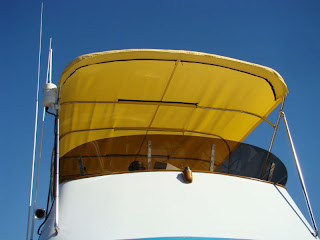With the "interior" makeover of the flybridge complete, the "exterior" was next on our list. Since the exterior of the boat has been painted in the past and we knew it was done in AwlGrip, the maintenance coat was a lot less labor intensive. First, all of the hardware and fittings were removed, including the vinyl lettering for her name. All edges had a double row of delicate tape to keep paint off of where it does not belong. Several screw holes that had mounted hardware that was no longer in use had to be filled and repaired. A good sanding and a single coat of 545 white primer and everything was ready for paint.
Two coats of AwlGrip Cloud White made the side look like new. Well, that is after a disaster with the first coat. The first coat took a bit long to dry because of the high humidity here in South Florida. Soon after sunset, a heavy dew began to form on everything and by morning, the dew was dripping on the deck as if it had rained. AwlGrip really doesn't like any moisture until it is completely dry, and sure enough, the finish had blushed, leaving a flat look about the same as the primer. OK, not a total loss since it needed another coat anyway. But what to do to keep this from happening over and over? The solution was to add an accelerator to the paint to cut down the drying time. Since I didn't have any, I had to order the 138 accelerator for brushing and rolling from Jamestown Distributors and wait a few days for it to arrive. As luck would have it, this slight delay also coincided with the arrival of a cold front coming down from the north. Now you might ask yourself what this has to do with anything? The cold front will clear out the atmosphere and bring dry air with lower humidity and dew points, perfect for painting since the chance of heavy dew, or almost any dew, is very low. Using the accelerator did the trick and with an early morning coat of paint, it was dry before the sun went down. I love it when a plan comes together. Now you probably wonder about the photo with the two black spots. After an extra day to allow for additional drying of the paint, all of the hardware and fittings needed to be re-installed. Rather than caulking, I now use butyl tape to bed all of the deck hardware. The recommended butyl tape is gray but I still had plenty left over from the installation of the ports. With the black, you must be careful not to use so much that it oozes out from under the hardware when it is tightened down. I am completely convinced that this is the ONLY way to bed hardware to ensure it won't develop leaks and can be easily removed if necessary.
The final results are a good-looking finish that will last us for another 10 years if we don't abuse it too much. This isn't quite finished yet, since the teak handrails and wood, now painted in the teal color, will have to be removed, the flybridge fiberglassed to the decks (I know I will hear about this) and the strip repainted. That's for another time.
The teak cap rail needed to be caulked to keep moisture out from under it. Both the teak and the fiberglass sides get a row of easy release tape and the caulking is applied. It had previously been done in white but we have found that a brown or teak color looks much nicer. For this we chose Boatlife Teak Caulk, something we have used around the window frames in the past. Caulking is messy, especially on new paint. The stuff grows legs when you aren't looking and walks all over your new paint. The darker the color the quicker it can crawl away.
I use my finger to smooth out the caulk after it's applied. Once the tape is removed, the edges of the caulk have a nice uniform, professional look. We use this technique no matter how large or small the caulking job is that we're working on.
The last step was to replace Beach House's name and the folks at SpeedySigns once again did a great job of sending us new vinyl lettering. I really can't say enough about their customer service.
We decided not to replace the Marine Trader teak plaque on the front of the flybridge. It needs some work and unless we can get it looking the way we want, it might not go back in place. We'll have to see if Susan can rejuvenate it. This all looks great and we are getting lots of compliments from the dock walkers and our boating neighbors. A few have threatened to hire me so I guess I will have to go into hiding for a while. Our next post will cover the replacement of the copper plumbing in the fresh water system so come back soon.
Subscribe to:
Post Comments (Atom)












No comments:
Post a Comment
Note: Only a member of this blog may post a comment.